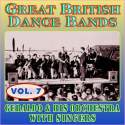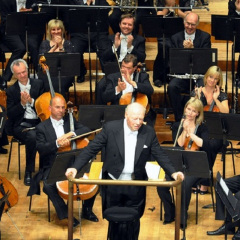
Geraldo & His Orchestra
地区:英国
生日:
经纪公司:
Gerald Walcan Bright, better known as Geraldo (10 August 1904, London, England – 4 May 1974, Vevey, Switzerland) was a British bandleader.
Bright adop
Gerald Walcan Bright, better known as Geraldo (10 August 1904, London, England – 4 May 1974, Vevey, Switzerland) was a British bandleader.
Bright adopted the name "Geraldo" in 1930 to become one of the most popular dance-band leaders of the 1930s with his "sweet music" and his "Gaucho Tango Orchestra". During the 1940s, he modernized his style to continue enjoying great success.
He played piano and organ and studied at the Royal Academy of Music in London. He started his career as a pianist playing for silent films.
Geraldo became a major figure on the British entertainment scene for four decades, having fronted just about every kind of ensemble and influenced the successful careers of numerous top singers. For his broadcasts he varied the style of his orchestra quite considerably, and a particular series Tip Top Tunes (employing a full string section alongside the usual dance band) enjoyed great popularity. Several commercial recordings were made, spotlighting the considerable arranging talents of the young Wally Stott (better known in the US as Angela Morley) .
Over the years, most of the UK's top musicians played with Geraldo's orchestra, including Ted Heath, who played first trombone in the orchestra before leaving to form his own band and the guitarist Ken Sykora, later to become a respected radio personality, and trumpeter Freddie Jameson.
In the 1950s he composed the start-up music for Scottish Television. Entitled Scotlandia, it was heard virtually every day for over thirty years at the beginning of programmes.
Geraldo died from a heart attack while on holiday in Switzerland in 1974. In 1993 a new Geraldo Orchestra, directed by trombonist Chris Dean, toured the UK provinces.
After World War II, Geraldo also ran an agency from his offices at 73 New Bond Street in London. In addition to booking bands for theatres and hotels, he placed musicians on transatlantic and cruise liners – in the music business this was known as "Geraldo's Navy".
From the mid-1930s for a period of some twenty years, American musicians were banned from performing in the UK by the British Musicians Union. The ban was in retaliation for a similar restriction in the USA which prevented British musicians from working in the States. It was especially frustrating for post-war British jazzmen who wanted to see and hear their American idols. However, one way for them to cross the Atlantic was to join the dance bands of Cunard liners such as the Queen Mary, Queen Elizabeth, Mauritania and the QE2, or Canadian Pacific vessels like the Empress of England and the Empress of Canada. The Cunarders were especially popular because when they had docked in New York, the musicians would have one or two nights free to visit jazz venues like Birdland on Broadway, just north of West 52nd Street in Manhattan, or clubs in Greenwich Village. Some even arranged to take lessons with American stars during their shore leave: for example, Bruce Turner took saxophone lessons with Lee Konitz.
In the public rooms of the liners, the musicians were required to play strict tempo dance music, but they would sometimes slip in the odd jazz number – especially if there was a chance that a celebrity passenger might sit in. Duke Ellington is known to have played piano with the ship’s dance band when he crossed from New York to Southampton aboard the Queen Mary in the late 1950s.
Many well-known figures in British post-war jazz "served" in Geraldo's musical navy, such as John Dankworth, Benny Green, Bill Le Sage, Ronnie Scott, and Stan Tracey.

















